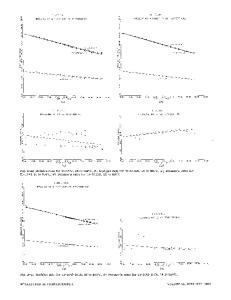Creep Deformation of Titanium Aluminides with TiB 2
- PDF / 325,389 Bytes
- 6 Pages / 420.48 x 639 pts Page_size
- 64 Downloads / 414 Views
CREEP DEFORMATION OF TITANIUM ALUMINIDES WITH TiB2
C. R. Feng and K. Sadananda Materials Science and Technology Division, Naval Research Laboratory, Washington, DC 20375
ABSTRACT Creep deformation of as-forged and heat-treated titanium aluminides, Ti-48A1 with 5 and 10% volume fraction of TiB2 , has been studied under tension in the temperature range of 649"871"C to determine the rate-controlling mechanism. Microstructure of these alloys correspond to a mixture of equiaxed grains of y and lamellar regions containing eutectoid Y+a2 .
Data indicate that with increase in load, stress exponent increases from one to seven. The activation energy for creep varies from 340kJ/mol to 455kJ/mol in the temperature range investigated. Creep data of these alloys were analyzed using several theoretical models. INTRODUCTION Tensile creep behavior of gamma-based titanium aluminides and composites was studied by several groups (1-11]. Most of these studies were limited to a narrow range of temperature or stress. Reported stress exponents vary from 3 to 5 [1-6 and 8-11], with an activation energy of 320kJ/mol [2-3, 5-7 and 9]. Occasionally, higher values of activation energy and stress exponent were also reported [6, 8 and 9]. Although there has been no direct evidence, power-law creep involving dislocation climb has been considered as the rate-controlling mechanism [3]. In this study, the creep tests were conducted in a broader load range. Systematic data evaluation was made and data indicated that as the load was increased, the stress exponent increased from 1 to 7. The stress dependence of creep rates was found to be better represented by a sinh function rather than by a power-law function. The implication of this in terms of creep mechanisms are discussed. EXPERIMENTAL PROCEDURE The materials used in this investigation were produced by a proprietary 'XD' process by Martin Marietta Laboratory and were forged. The nominal compositions were Ti-48at%Al+5vol%TiB 2 (Ti48A1+5TiB 2 ) and Ti-48at%Al+I0vol%TiB2 (Ti-48AI+lOTiB 2 ). Specimens were tested in as-forged condition. Some specimens of Ti-48AI+5TiB 2 were heat-treated at 1250"C/16h+900"C/8h. The microstructures of all materials contain about 85voi% of equiaxed y-TiAl grains and 15vol% of grains with y-TiAl/a 2 -Ti 3 Al lamellar structure. The average grain sizes in as-forged Ti48AI+5TiB2 and Ti-48AI+lOTiB 2 were 2011m and 14gm, respectively. However, some large grains (-100Jm) with lamellar structure were occasionally observed. The size of the TiB2 particulate ranged from lilm to 31m. Mat. Res. Soc. Symp. Proc. Vol. 288. 01993 Materials Research Society
1156
The round button-head tensile specimens with gage length 25.4mm and gauge diameter of 3.8mm were machined from specimen blanks. The creep deformation behavior was studied in the temperature range of 649" - 871"C using a constant load lever arm creep-frame. The displacement as a function of time was measured using a LVDT with connecting rods fixed to the specimen shoulders. The specimens were thermally stabilized in the cr
Data Loading...











